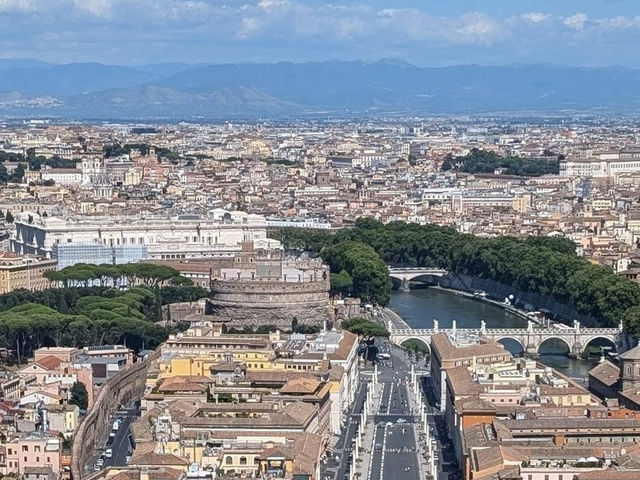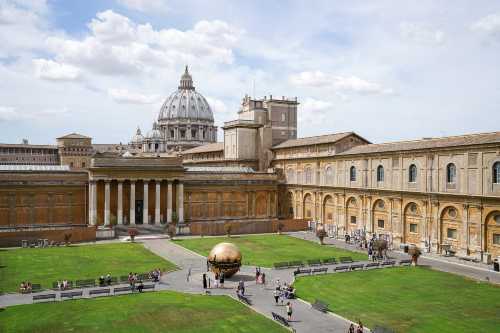Popular Trip Moments
Vatican | Free visit to St. Peter's Basilica | Vatican Rome ‖ The Intersection of Memory and Glory in the Eternal City | Rome’s Silent Storytellers 🏛️✨ | Rome Reimagined: Eternal Reflections by the Tiber 🌿🏛️ | A Must-Visit in Rome: A One-Day Tour Guide to the Tiny Country Vatican City | ⛪ St. Peter’s Basilica – The Soul of Vatican City | Spooky Rome Night🎃 | St. Peter's Basilica in the Vatican is so beautiful that people can't leave | Vatican City: The World's Smallest Yet Most Beautiful Country | St. Peter's Basilica (Basilica di San Pietro in Vaticano) | The Place Where the Art of the Gods Breathes, Vatican Museums (Musei Vaticani) | Vatican Museums — A Sanctuary of Genius Artists | A must-see for European-style ancient buildings🏛 | Pio-Clementino Museum – The Crown Jewel of Ancient Sculpture in the Vatican | Rome 2 days 1 night 🇮🇹 | Golden Hour Glow✨ | Basilica Majesty✨ | Vatican City | Vatican City | 🎨 Vatican Museums — A Half-Day Journey Through Art & History | Pilgrimage to the Holy City of Vatican! ✨ | 【Vatican】St. Peter's Basilica: One of the World's Largest Churches | Rome and Vatican City Travel Notes | A Journey Through Art, History, and Faith | Vatican City's Artistic Paradise 🎨 | One Day in Vatican City: Tips & Tricks 🇻🇦 | [Vatican City🇻🇦] Climb the dome of the cathedral❗
Recommended Attractions at Popular Destinations
Popular Attractions in Kuala Lumpur | Popular Attractions in Iguazu National Park(Argentina) | Popular Attractions in Walt Disney World Resort | Popular Attractions in Dubai | Popular Attractions in Paris | Popular Attractions in Los Angeles | Popular Attractions in Barcelona | Popular Attractions in Bangkok | Popular Attractions in Rome | Popular Attractions in London | Popular Attractions in Singapore | Popular Attractions in Osaka | Popular Attractions in New York | Popular Attractions in Zanzibar Island | Popular Attractions in Bali | Popular Attractions in Melbourne | Popular Attractions in Beijing | Popular Attractions in Shanghai | Popular Attractions in Sydney | Popular Attractions in Las Vegas | Popular Attractions in Tokyo | Popular Attractions in Chefchaouene | Popular Attractions in Kyoto | Popular Attractions in Phuket | Popular Attractions in West Lake | Popular Attractions in Chengdu | Popular Attractions in Florence | Popular Attractions in Madrid | Popular Attractions in Istanbul | Popular Attractions in Jungfrau Region
Popular Restaurants in Vatican
Popular Ranked Lists
Top 10 Best Things to Do in Nagasaki | Popular Luxury Hotels in Central Java | Top 50 Must-Visit Restaurants in Phuket | Top 50 Must-Visit Restaurants in Chiang Mai | Popular Luxury Hotels in Helsinki | Top 50 Must-Visit Restaurants in Bali | Top 50 Must-Visit Restaurants in Hanoi | Top 50 Must-Visit Restaurants in Barcelona | Top 50 Must-Visit Restaurants in Singapore | Top 50 Must-Visit Restaurants in Seoul | Popular Luxury Hotels in Incheon | Top 50 Must-Visit Restaurants in Melbourne | Top 50 Must-Visit Restaurants in Shanghai | Popular Luxury Hotels in Aba Prefecture | Popular Luxury Hotels in Genting Highlands | Popular Luxury Hotels in Busan | Top 50 Best Things to Do in Saint Petersburg | Popular Best Things to Do in Boracay Island | Top 50 Must-Visit Restaurants in Kyoto | Popular Luxury Hotels Near Longnan | Popular Premium Hotels in Hsinchu | Top 50 Best Things to Do in Milan | Popular Premium Hotels in New Taipei City | Popular Luxury Hotels in San Francisco | Popular Premium Hotels in Taitung | Top 50 Best Things to Do in Melbourne | Top 10 Best Things to Do in Doha | Popular Luxury Hotels in Bora Bora | Top 10 Local Restaurants in Lushan Global Geopark | Top 50 Must-Visit Restaurants in Jeju
About
Payment methods
Our partners
Copyright © 2025 Trip.com Travel Singapore Pte. Ltd. All rights reserved
Site Operator: Trip.com Travel Singapore Pte. Ltd.
Site Operator: Trip.com Travel Singapore Pte. Ltd.




















